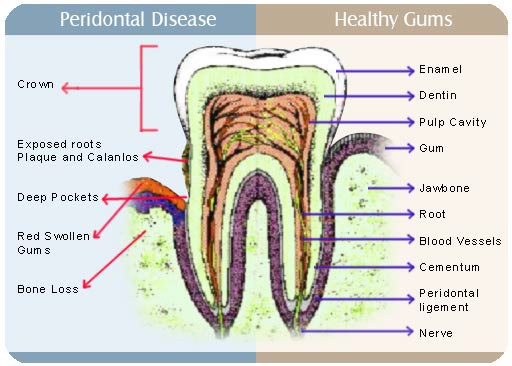FLAP SURGERY
Your teeth are at risk because of Gum disease. It began with the buildup of patch and tartar on your teeth, which may have resulted from insufficient brushing and flossing. Over time, the plaque and tartar have caused loss of the surrounding tissue around some of your teeth.
When patch builds up on a tooth, bacteria in the patch attack the bone around the tooth as well as the fibers, which connect the tooth to the bone. As the fibers and bone are destroyed, a pocket or space forms between the gum and the tooth- an ideal site for more patch to build up. Without proper hygiene, the process may continue, sometimes without symptoms, until the tooth is endangered.

Why do you need periodontal (osseous) gum surgery..?
This surgical procedure is used by the periodontist to smooth / correct defects and irregularities in the bone surrounding the diseased teeth with the ultimate goal of eliminating spaces around teeth.
What exactly we do during gum surgery?
Do not let the word “Surgery” scare you except in complex cases.
Once the area is made numb with local anesthesia, gums are raised so that we can visualize the amount and type of bone loss. We can also visualize tartar that may be attached to the roots.
We, then remove the tartar and scoop out the diseased tissue from the bone defects. This infected material / tissue is basically responsible for the progression of your gum diseases. Next, we use hand instruments called Curettes to smoothen your root surfaces.
Once the bone defects are re-shaped and your root surfaces are cleaned, the gum is placed back in its original position and stitches are placed.
Postoperative instructions are then given to teach you how to take care of the area so that as little discomfort will take place as possible.

Gum pocket and bone irregularity before surgery.

Gum is exposed for access to the bone and root.

Bone irregularities are removed.

Gum tissue is sutured back around the tooth.

After healing, the gum is tightly “sealed” around the tooth.
What are the precautions after gum surgery?
Post Procedure Instructions
- Bleeding: Some bleeding may occur within the first 24 hours following surgery. This is normal. If this should occur, apply gentle pressure to the area with a piece of sterile cotton or wet gauze.
- Working-Exercise: You can carry out your normal routine activities like going to work etc., but avoid any kind of strenuous exercise.
- Diet: You are recommended to follow a soft and cold diet for a few days. Avoid consumption of hot beverages for atleast 2 to 3 days after surgery. Preferably, chew from the other side which is not surgically treated.
- Smoking – Alcohol: Alcohol should be restricted during the first 48 hours following surgery. Please abstain from smoking for atleast 2 weeks after surgery as smoking has been shown to slow down the healing process..
- Medication: If any medication has been suggested for comfort and/or the prevention of infection during the healing process, please follow the directions carefully.
- Ice Packs for Swelling: If there is any swelling, ice packs should be applied to the area during the first four hours after surgery (use 15 minutes on 15 minutes off). Some swelling can be expected during the first 24 hours.
- Saltwater Rinse: Using teaspoon of salt in a glass of warm water, you may rinse the treated area gently. Rinsing several times in the first twelve-hour period will help keep your mouth fresh and odor-free. However, vigorous rinsing should be avoided in the first 24 hours.
- Brushing: Try to avoid brushing over the surgical area for at least 5 to6 days after surgery as it may dislodge or loosen the sutures. Brushing can be started once the sutures are removed. Meanwhile the area can be kept clean by massaging the area with the finger and paste and also with the help of a mouthwash.
- Surgical Dressing: If necessary a periodontal dressing will be placed over the treated area which protects the surgical site and should remain in place for approximately one week. Small pieces may break off but this should be of no concern. However, if the complete dressing should come off within three days, please call to have it replaced. If this should occur after the fourth day, there is no need for concern so long as there is no discomfort. Continue to rinse the area with warm salt water until your next appointment
What are the recent advances in surgery?
Periodontal surgery has evolved with newer techniques and materials advancing the art and science of dentistry.
REGENERATION is a present concept where the tissues that are lost due to periodontal disease are reconstructed to a certain extent using newer and advanced techniques.
Various methods of regeneration used at Area Dental are:
- Bone Grafts
- Guided Tissue Regeneration
Is flap surgery a permanent cure?
As you have learned, you may be prone to gum diseases that require constant and careful attention. Like other chronic diseases, such as diabetes, hypertension and asthma, there is no permanent cure. Gum surgery helps control disease and prevents further destruction to the gums and bone, thereby minimizing tooth loss. Regular check-ups would ensure tooth loss is further minimized.
